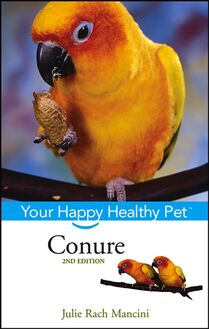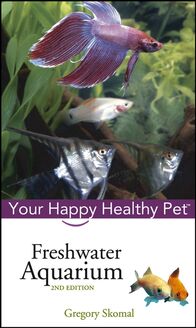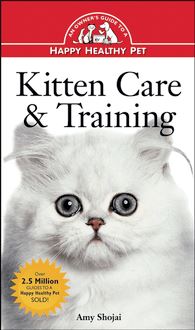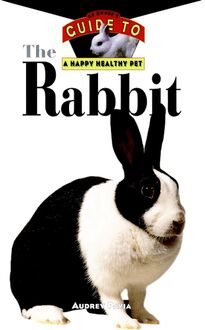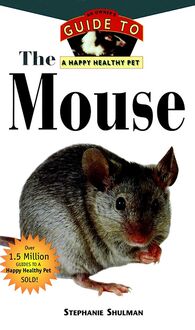-
 Univers
Univers
-
 Ebooks
Ebooks
-
 Livres audio
Livres audio
-
 Presse
Presse
-
 Podcasts
Podcasts
-
 BD
BD
-
 Documents
Documents
-
- Cours
- Révisions
- Ressources pédagogiques
- Sciences de l’éducation
- Manuels scolaires
- Langues
- Travaux de classe
- Annales de BEP
- Etudes supérieures
- Maternelle et primaire
- Fiches de lecture
- Orientation scolaire
- Méthodologie
- Corrigés de devoir
- Annales d’examens et concours
- Annales du bac
- Annales du brevet
- Rapports de stage
La lecture à portée de main
Vous pourrez modifier la taille du texte de cet ouvrage
Découvre YouScribe en t'inscrivant gratuitement
Je m'inscrisDécouvre YouScribe en t'inscrivant gratuitement
Je m'inscrisEn savoir plus
Vous pourrez modifier la taille du texte de cet ouvrage
En savoir plus

Description
- feeding
- grooming
- housing
- health care
- what to expect from the pet
- basic training
Happy, Healthy Pet guides are rich with professional quality color photos and are designed to be enjoyable and easy to learn from.
PART ONE: Welcome to the World of the Lovebird.
1. About Lovebirds.
2. Choosing the Best Lovebird.
3. All Kinds of Lovebirds.
PART TWO: Living with a Lovebird.
4. Your Lovebird's Home.
5. Caring for Your Lovebird.
6. Feeding Your Lovebird.
7. Keeping Your Lovebird Healthy.
PART THREE: Enjoying Your Lovebird.
8. Your Lovebird's Behavior.
9. Having Fun with Your Lovebird.
PART FOUR: Beyond the Basics.
10. Resources.
Sujets
Informations
| Publié par | Turner Publishing Company |
| Date de parution | 27 août 2007 |
| Nombre de lectures | 0 |
| EAN13 | 9780470253021 |
| Langue | English |
| Poids de l'ouvrage | 2 Mo |
Informations légales : prix de location à la page 0,0750€. Cette information est donnée uniquement à titre indicatif conformément à la législation en vigueur.
Extrait
The
Lovebird
Howell Book House
A Simon Schuster Macmillan Company
1633 Broadway
New York, NY 10019
Macmillan Publishing books may be purchased for business or sales promotional use. For information, please write: Special Markets Department, Macmillan Publishing USA, 1633 Broadway, New York, NY 10019.
Copyright 1998 by Howell Book House
All rights reserved. No part of this book shall be reproduced, stored in a retrieval system, or transmitted by any means, electronic, mechanical, photocopying, recording, or otherwise without written permission from the publisher.
MACMILLAN is a registered trademark of Macmillan, Inc.
Library of Congress Cataloging-in-Publication Data
Higdon, Pamela Leis.
The lovebird: an owner s guide to a happy, healthy pet / Pamela Leis Higdon.
p. cm.
ISBN 0-87605-430-0
1. Lovebirds. I. Title. II. Series.
SF473.L6H54 1997
636.6'864-dc21 97-14731
CIP
Manufactured in the United States of America
10 9 8 7 6 5 4 3 2 1
Series Director: Amanda Pisani
Series Assistant Director: Jennifer Liberts
Book Design: Michele Laseau
Cover Design: Iris Jeromnimon
Illustration: Laura Robbins
Photography:
Front and back cover by Ren e Stockdale
Joan Balzarini: 14, 78
Diane Gordon: 106
Eric Ilasenko: 20, 21, 31
Ren e Stockdale: i, 6, 8, 13, 19, 22, 42-43, 45, 46, 50, 52, 56, 57, 61, 64, 66, 70, 71, 72, 76, 82, 87, 89, 92, 92, 100, 102, 103, 104, 110, 112, 114, 119
Faith Uridel: 5
B. Everett Webb: 2-3, 10, 11, 12, 15, 23, ,25, 26, 28, 29, 30, 32, 40, 44, 47, 51, 63, 68, 69, 74, 85, 98-99, 105, 108, 109, 120, 122
Production Team: Trudy Coler, Stephanie Hammett, Clint Lahnen, Stephanie Mohler, Dennis Sheehan and Terri Sheehan
Contents
part one Welcome to the World of the Lovebird
1 About Lovebirds
2 Choosing the Best Lovebird
3 All Kinds of Lovebirds
part two Living with a Lovebird
4 Your Lovebird s Home
5 Caring for Your Lovebird
6 Feeding Your Lovebird
7 Keeping Your Lovebird Healthy
part three Enjoying Your Lovebird
8 Your Lovebird s Behavior
9 Having Fun with Your Lovebird
part four Beyond the Basics
10 Resources
part one
External Features of the Lovebird
chapter 1
About Lovebirds
Fascination with birds leads many of us to want to bring them into our homes as pets. Learning as much as you can about a bird s species before you buy it is the best possible course for both you and the bird. Each species, and often members of a subspecies, has a personality that may or may not mesh with you and your needs. A thorough understanding of a bird s needs, as well as your own, will help you make the wisest possible choice.
Birds do not require a daily walk or a great deal of space. Nor do they need a litter box. They do require love and companionship, understanding, a balanced diet and knowledgeable care. A treasured, properly cared for, healthy lovebird might live as long as 15 or 20 years. If you have considered carefully and have chosen the right bird for your lifestyle, every year with your lovebird can be a delight. You can wake up to her cheery chirps, share many happy moments each day and tuck her into bed with the feeling of happiness that only unconditional companionship and affection can bring.
Is a lovebird for you? The information in this book should help you decide. As you read, consider whether the needs of this charming, beautiful little parrot will fit your personality and lifestyle. A close match will help to ensure that you and a lovebird will make great companions.
A Historical Perspective
The first birds lived on earth long before humans, during the Jurassic Period, the days of the dinosaur. Occupying the air with the first birds were flying reptiles, which had begun to develop about 35 million years before. At this time, we believe that Archeopteryx lithographica was the first feathered, flying animal-or bird.
Birds inhabited the earth during the Jurassic Period-about 140 million years ago!
By studying fossils, paleontologists have learned that the first birds lived about 140 million years ago in cycad forests and were about the size of a present-day crow. Cycads are tropical and semi-tropical cone-bearing plants that are similar to palm trees. Because bird bones are lightweight or hollow to allow flight, they did not preserve well as fossils. As a result, we don t have a detailed fossil record of all the bird species that we believe may have developed between Archeopteryx and birds that live today.
Experts disagree on when parrots developed. Some accept the earliest ancestor to be Archeopteryx verreauxi , found in France and dating from about 30 million years ago. Others believe Conuropsis fratercula , found in Nebraska and dating from 20 million years ago, is the most parrot-like of ancient birds. Fossils of other parrots found in South America date from at least one million years ago.
PARROT PARTICULARS
The lovebird shares certain traits with the Yellow-Fronted Amazon and the African Grey because they are all members of parrot species. Characteristics that all parrot species have in common include four toes-two pointing backward and two pointing forward upper beak hanging over the lower broad head and short neck
As birds developed ways to survive, such as the ability to maneuver on the ground as well as in the air, they eventually became quite successful at finding food and claiming territories in which to live and hunt. In addition, their high rate of metabolism and warm-blooded natures gave them an edge over other animals, especially reptiles. As the number of birds increased, they competed more successfully for food, and flying reptiles eventually died out.
Today, more than 8,000 species of birds live all over the earth, although their numbers are in constant decline because of the loss of habitat and the vast numbers of wild birds captured for sale as pets. Of those, about 350 species are parrots.
What Is a Parrot?
Parrots come in all shapes and sizes. The most distinctive feature they all have is their beak. The curved upper mandible that fits neatly into the lower mandible works well to break open seeds, nuts, bones and other foods relished by parrots. The tongue is thick and used with the beak to remove foods from husks or other coverings. Parrots have distinctive feet, shared by only a few other birds, including woodpeckers. Two toes point forward and two point backward. This arrangement allows them to grip branches and other perches, as well as to walk with a waddling gait on the ground. Some parrots use their feet to grasp food as they eat. Others may stand on larger pieces of food to secure them as they eat.
Feathers cover all parts of a bird-from his head to the tip of his tail. Only his beak, eyes, legs and feet remain uncovered by feathers. The layer of feathers closest to the skin is called down . It is soft and fluffy and helps keep the bird warm. Parrots also have powder barbs , which are a kind of down feather. These feathers grow throughout a parrot s life and break off into bits so fine they resemble dust or powder; some species have more than others. Cockatoos, for instance, are noted for their heavy powder. This powder helps keep parrot feathers clean. The outer feathers are called contour feathers and include those on the wings and tail. These are the feathers you will see first; they cover the outline, or contour, of the bird and come in various colors. Current opinion on the matter is that colors serve as either good camouflage in the bird s native habitat or as a way to attract a mate.
Feathers grow throughout a lovebird s life-serving as enticement for a potential mate as well as camouflage .
Parrots have broad skulls and short, skinny necks. The first time you feel a parrot s neck, you may be in for a surprise. It feels like a chicken or turkey neck-thin and bony. This neck is surprisingly mobile. A parrot can move his head 180 very quickly. Like other birds, parrots have excellent eyesight, far better than that of any human.
The largest parrot in the world is the Hyacinth Macaw (about 3 feet long) from South America. The smallest is the 3-inch-long Pygmy Parrot from New Guinea. South America and Australia have many native species, Africa only a few. North America had two native species, the Carolina Parakeet and the Thick-billed Parrot. Accounts from the 1800s report clouds of these birds. Hunters killed both to extinction in the United States, although populations of Thick-billed Parrots still live in Mexico. Presently, attempts to re-introduce Thick-billed Parrots into the United States have been largely unsuccessful.
What Is a Lovebird?
A lovebird is a short, thick-bodied parrot about 5 to 6 inches long from head to tail. He has a relatively large beak for his size. The basic, or ground, color of lovebirds is green. This group of birds was named lovebirds because they groom each other constantly and sit as close together as possible when resting or sleeping.
W HERE L OVEBIRDS F IT I N
Lovebirds are classified as belonging to the order Psittaciformes . They are members of the family Psittaccidae and the genus Agapornis . They all come from Africa and the island of Madagascar, off Africa s east coast. Although the ground color of wild lovebirds is green, some species also have gray, pink, red, blue and yellow feathers. In addition, mutations developed by breeders come in many other hues.
WHAT S IN A NAME?
All lovebirds belong to the genus Agapornis . The genus name is a part of the scientific name, which will appear with more detailed discussions of each species. The scientific name is important because the common name for an animal can vary from country to country and even within a country, causing a great deal of confusion. When the scientific name is used, this confusion is avoided.
Common names are often based on a bird s coloration, who discovered or was somehow connected with the discovery of the bird or where the bird comes from in the wild. The Ny
-
 Univers
Univers
-
 Ebooks
Ebooks
-
 Livres audio
Livres audio
-
 Presse
Presse
-
 Podcasts
Podcasts
-
 BD
BD
-
 Documents
Documents
-
Jeunesse
-
Littérature
-
Ressources professionnelles
-
Santé et bien-être
-
Savoirs
-
Education
-
Loisirs et hobbies
-
Art, musique et cinéma
-
Actualité et débat de société
-
Jeunesse
-
Littérature
-
Ressources professionnelles
-
Santé et bien-être
-
Savoirs
-
Education
-
Loisirs et hobbies
-
Art, musique et cinéma
-
Actualité et débat de société
-
Actualités
-
Lifestyle
-
Presse jeunesse
-
Presse professionnelle
-
Pratique
-
Presse sportive
-
Presse internationale
-
Culture & Médias
-
Action et Aventures
-
Science-fiction et Fantasy
-
Société
-
Jeunesse
-
Littérature
-
Ressources professionnelles
-
Santé et bien-être
-
Savoirs
-
Education
-
Loisirs et hobbies
-
Art, musique et cinéma
-
Actualité et débat de société
- Cours
- Révisions
- Ressources pédagogiques
- Sciences de l’éducation
- Manuels scolaires
- Langues
- Travaux de classe
- Annales de BEP
- Etudes supérieures
- Maternelle et primaire
- Fiches de lecture
- Orientation scolaire
- Méthodologie
- Corrigés de devoir
- Annales d’examens et concours
- Annales du bac
- Annales du brevet
- Rapports de stage



